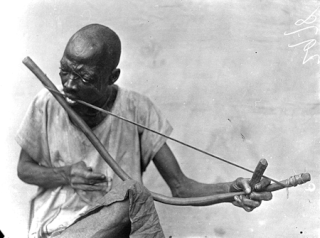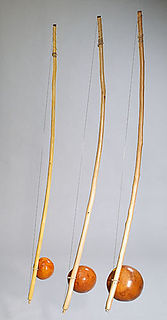Related Research Articles

String instruments, stringed instruments, or chordophones are musical instruments that produce sound from vibrating strings when the performer plays or sounds the strings in some manner.

A chordophone is a musical instrument that makes sound by way of a vibrating string or strings stretched between two points. It is one of the four main divisions of instruments in the original Hornbostel-Sachs scheme of musical instrument classification.

The musical bow is a simple string instrument used by a number of South African peoples, which is also found in the Americas via slave trade. It consists of a flexible, usually wooden, stick 1.5 to 10 feet long, and strung end to end with a taut cord, usually metal. It can be played with the hands or a wooden stick or branch. It is uncertain if the musical bow developed from the hunting bow, though the San or Bushmen people of the Kalahari Desert do convert their hunting bows to musical use.
In music, a bow is a tensioned stick which has hair coated in rosin affixed to it. It is moved across some part of a musical instrument to cause vibration, which the instrument emits as sound. The vast majority of bows are used with string instruments, such as the violin, although some bows are used with musical saws and other bowed idiophones.

The berimbau is a single-string percussion instrument, a musical bow, from Brazil. Originally from Africa where it receives different names, the berimbau was eventually incorporated into the practice of the Afro-Brazilian martial art capoeira, the berimbau leads the capoeiristas movement in the roda—the faster the berimbau is playing the faster the capoeirista moves in the game. The instrument is known for being the subject matter of a popular song by Brazilian guitarist Baden Powell, with lyrics by Vinicius de Moraes. The instrument is also a part of Candomblé-de-caboclo tradition.

The đàn bầu also đàn độc huyền is a Vietnamese stringed instrument, in the form of a monochord (one-string) zither.

The tro is Cambodia's traditional spike fiddles, bowed string instruments that are held and played vertically. Spike fiddles have a handle that passes through the resonator, often forming a spike, on the bottom side where it emerges. The family is similar or distantly related to the Chinese erhu or huqin. The instruments have a soundbox at the bottom of the stick, covered with leather or snake skin. Strings run from pegs at the top of the stick and secured at the bottom, running across the soundbox. The larger the soundbox, the lower the pitch range. Instruments in this family include the two-stringed tro ou, tro sau thom, tro sau toch and tro che, as well as the three-stringed tro Khmer spike fiddle. The two-stringed tros are tuned in a fifth, while the three-stringed tro Khmer is tuned in fourths. The tros, with the exception of the tro Khmer, are strung so that the bowstring is permanently placed between the two stings. When the musician plays, the placement of the bow causes the strings to be played at once, one from below and one from above. In contrast, western fiddles are played with the bow pushing on each string from the outside, as is also the case with the tro khmer.

The Sarasvati vīṇa is an Indian plucked string instrument. It is named after the Hindu goddess Saraswati, who is usually depicted holding or playing the instrument. Also known as raghunatha veena is used mostly in Carnatic Indian classical music. There are several variations of the veena, which in its South Indian form is a member of the lute family. One who plays the veena is referred to as a vainika.
The kalumbu, or kalumbo, is a traditional instrument of the Tonga and Ila people of Zambia and Zimbabwe. A single metal-stringed bow played with a stick is lashed onto a calabash gourd that acts as a resonating chamber. The kalumbu player manipulates the resonance of the instrument by moving the gourd toward and away from his or her chest. Though now quite rare in Africa, the kalumbu is considered the predecessor of the Afro-Brazilian berimbau used in Capoeira performances.
The malunga is a single-stringed musical bow played by the Siddi of India, who are the descendants of East African immigrants. It produces two tones, an octave apart, and the knuckle of the hand supporting the instrument may be pressed against the string to vary the pitch. It is struck with a stick and, as with the berimbau of Brazil, the hand holding the stick also holds a rattle. The malunga has a gourd resonator which amplifies the instrument's sound. The placement of this rattle along the string also varies the pitch produced by the Malunga.

The umuduri is a Burundian and Rwandan stringed instrument. It is a musical bow consisting of a string supported by a flexible wooden string bearer or bow that is 125–135 cm in length. The string is traditionally made from plant fiber and animal gut, however, metal wire is becoming widespread.
Traditional Thai musical instruments are the musical instruments used in the traditional and classical music of Thailand. They comprise a wide range of wind, string, and percussion instruments played by both the Thai majority as well as the nation's ethnic minorities.

Traditional Cambodian musical instruments are the musical instruments used in the traditional and classical musics of Cambodia. They comprise a wide range of wind, string, and percussion instruments, used by both the Khmer majority as well as the nation's ethnic minorities.

The saw duang is a two-stringed instrument used in traditional Thai music. The sound is produced by the bow made from horsetail hair which goes between the strings made from silk. The bow has to be tilted to switch from one string to another. Saw duang is light and played vertically on the lap. It creates a bright tone unlike the Saw u which produces a mellow sound. Another instrument which is similar to the Saw duang is the Chinese stringed instrument called Huqin.

The veena comprises a family of chordophone instruments from the Indian subcontinent. Ancient musical instruments evolved into many variations, such as lutes, zithers and arched harps. The many regional designs have different names such as the Rudra veena, the Saraswati veena, the Vichitra veena and others.
The Uhadi musical bow is a traditional Xhosa musical instrument. It is a large unembraced musical bow which is attached to a resonator and played by percussion. The length of the string bow ranges from 115 to 130 centimeters. Similar musical bows in Southern Africa include the ‘’thomo’’ in Sotho music and the ‘’ugubhu’’ in Zulu music.
References
- 1 2 3 Pangelinan, Therese Q. Crisostomo (July 14, 2014). "Belembaotuyan". guampedia.com. Retrieved 2015-01-22.